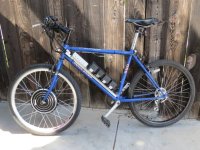

Tool batteries are great for ebike power. My experience is with Genuine Makita 18V and much cheaper Chinese clones sold "for Makita". But, I think you can expect the similar result from DeWalt's and other quality tool makers.
I've converted 3 tandem using 36V 800W front hub kits and a bunch of single bikes using 36V 500W front kits. The tandems have six battery slots (2s3p), the singles 4 (2s2p). The batteries load and lock just like putting a battery on you drill.
The advantage of using tool batteries.
1. Cost
2. Rugged construction and designed to be abused, dropped.
3. Very high amps with very little voltage drop.
4. Fast recharge: typically 30 to 45 minutes in a Makita charger(battery is fan cooled during charging). Newer Makita batteries balance charge each cell.
5. Flexibility. Just carry the # of batteries you need. If your trip is less than 10 miles, two 5ah batteries will get you there. If you need to go 40-50 miles, mount 4 and carry 4 in a bike bag. Why carry the weight of a big battery if the trip is short?
6. You can use also use the batteries in your tools.
7. Tool batteries have long warranties. Makita; 3 years. I haven't had one fail, but I understand it's a full replacement.
Genuine Makita 18V Li Ion batteries use ten, 2.1ah/cell Sony SE US18650vt4 in the 4.0ah battery; ten, 2.6ah/cell SE US18650vt5 in the 5.0ah battery. These Lithium nickel manganese cobalt 18650 cells are rated at 30amps continuous; 60amps peak/cell. Since these batteries are 5s2p, 60amps continuous is available. When I ride with only 2 battery, the range is cut, but the performance is not. On the 500W single bikes, I see 800 to 900 watts (22-25amps) accelerating from a stop and on hills, even with only 2 batteries.
Don't expect the full AH rating of printed on the battery. The Sony cells do deliver the 2.1ah and 2.6ah promised, but only under the following conditions. Charged to 4.2v/ cell then discharged at .5A/cell to 2.5 volts. Makita's chargers don't charge cell to 4.2v , but 4.05 to 4.1v. This knocks off some capacity, but increases the number of recharge cycles significantly. (remember, they promise 3 years!) Bikes and tools use a lot more than current than .5A/cell and most controllers cut off at 20v (3.0v/cell). You should expect about 85% of the rated capacity of a new battery in actual use. That will decrease over time. Ebike battery builders do the same thing. They rate the battery using the specs of cells used.
The Chinese copies are less than half the price of genuine Makita batteries. There are 2 kinds.
The first uses chinese made 18650 cells that are built to have low capacity and discharge rate and very are cheap. They may work in your drill if recharged often, but would be terrible on an e bike. If you ask the seller what cells are inside, they usually won't answer.
The second kind is worth considering. Billions of 18650 cells are produced each year by Sony, Samsung, LG, and few others. Millions do not pass the QC test; low capacity, voltage too low at high rate. They are graded (#2 #3 etc). #2's don't miss specs by much. Most Chinese battery companies don't actually make cells, but put a new wrap and label on "fails" from Samsung, etc. Samsung won't allow a re-label to say "Samsung", so it's gets no label, a private label, or its made to look like another major brand. 99% of the time "these new cells" are sold with greatly inflated specs. The ones I tested were Samsung cells 2.1ah 25amp cells wrapped and labeled to look like 2.5ah 25amp LG cells. To avoid counterfeit laws, 1 character of LG's label is changed. When you ask the seller of the Makita clone batteries, he say they use genuine Samsung or LG cells. Ya, sort of.
Pictures are of a 1984 Univega Superstrada conversion, and a 90's mountain bike.



